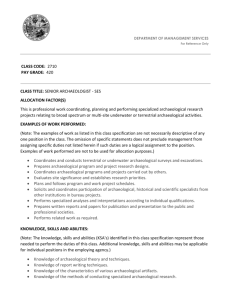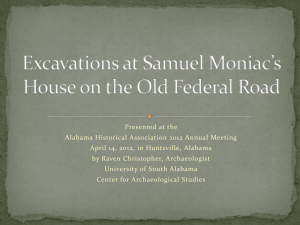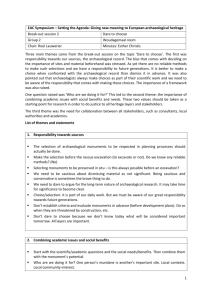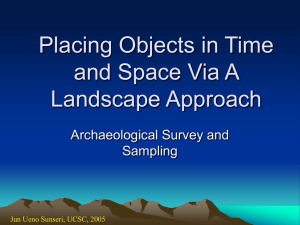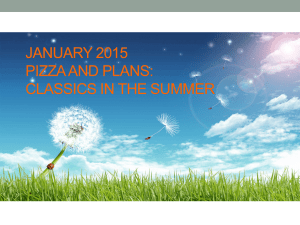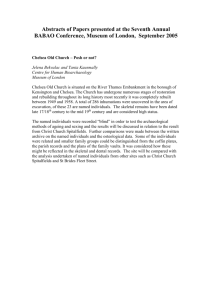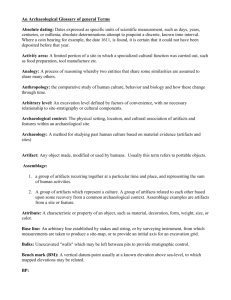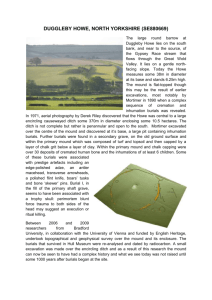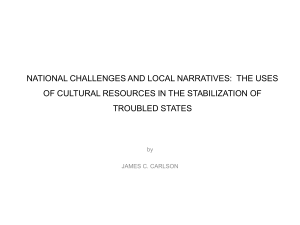Year 11 revision
advertisement
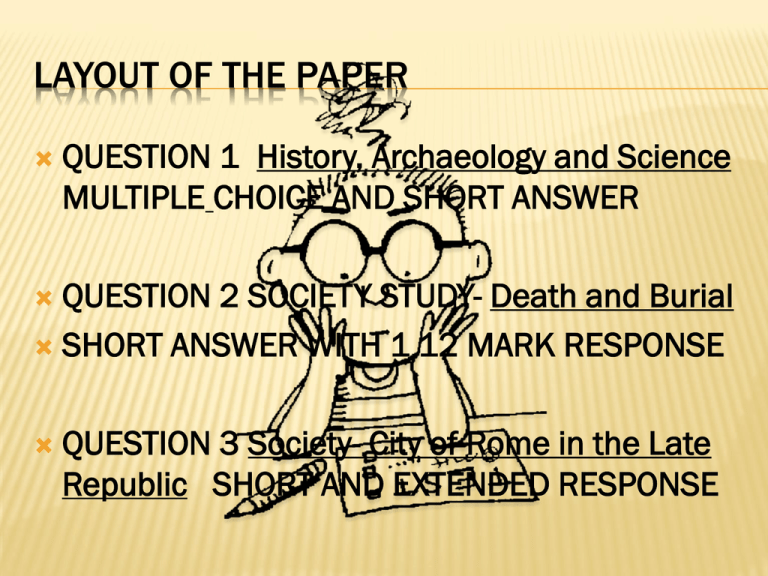
LAYOUT OF THE PAPER QUESTION 1 History, Archaeology and Science MULTIPLE CHOICE AND SHORT ANSWER QUESTION 2 SOCIETY STUDY- Death and Burial SHORT ANSWER WITH 1 12 MARK RESPONSE QUESTION 3 Society- City of Rome in the Late Republic SHORT AND EXTENDED RESPONSE PACING This is a 2 hour paper to complete 3 topic questions This allows 40 minutes per topic. The mini extended responses should take up at least 20 minutes. If the average writing speed is 30 words per minute these responses should be around 600 words. Ancient History requires good memory and strong wrists!!!!!!!!!!!!!!! YEARLY EXAM STRUCTURE Question 1 ( similar to HSC core, BUT WILL HAVE A broadsheet attached with sources A-F) There will now be multiple choice questions, the number may vary.( 7) All multiple choice questions can be answered from the sources Question 8 will be a describe question for 6 marks. Where you are able to use the given source and sources of your own Question 9 is the 10 mark extended response using one source and your own knowledge explain……. EXAM TECHNIQUE Part 9 will be an extended response worth 10 marks. Do not be limited by the space. Be limited by your time. Question 1-9 will be completed on the exam paper but backs of pages and spare paper will be given Extended response questions could be ; Discuss the significance of ……,Explain the importance of. SYLLABUS DOT POINTS 1 Methods of investigating the historical past • roles of history and archaeology in investigating the past; complementary nature of both disciplines • the unique methodologies of the historian and archaeologist; the contribution of written and material remains in providing evidence of the past 2 The nature of sources and evidence • archaeological and written sources; how evidence is lost, preserved and rediscovered • the nature of evidence provided by written and archaeological sources, complementary and contradictory • asking questions of archaeological and written sources • determining the reliability of archaeological and written sources • historiographical issues raised by archaeological and written sources 3 Reconstructing the past: the role of sources and evidence • reconstructing the past using archaeological and written sources; analysis of sources for use as evidence; recognising the provisional nature of the evidence • testing hypotheses using types of sources; complementary and contradictory evidence; determining authenticity, reliability and usefulness of sources • forensic techniques used to bring together a coherent picture of a person, group, event and site; problems of authenticity – fakes and forgeries • history of archaeology – changing purposes, excavations and recording techniques SOURCE BASED • archaeological conservation and preservation – preservation techniques, the role of science and disputation over ‘reconstruction of historic sites’ • problems associated with reconstructing the past through archaeological evidence – ancient customs and religious beliefs • different interpretations of the past • influence of different perspectives on interpretations of the past • significance of selectivity, emphasis and omission for the interpretation of the past ESSAY STYLE 4 Current concerns relating to the ethics of the discipline • Who owns the past? Who should administer the past? Who presents the past? • human remains – ethical issues involved in their analysis and uses • cultural property – ownership and custodianship 5 The role of science in unlocking the past • contributions of science and other disciplines to the analysis and reconstruction of the past: – biology – medicine – physics – geography – geology – chemistry – computer science – mathematics – sociology – anthropology – cartography – epigraphy – numismatics – vulcanology – papyrology – dating of evidence POWERPOINTS ;FINDING AND DATING EVIDENCE BIAS- CONSCIOUS AND UNCONSCIOUS Contextual bias of author, personal, social and historical. Gender and Class bias Bias of ommission Evidence lost or destroyed, renders the past incomplete HISTORICAL CONTEXT SOCIAL CONTEXT PERSONAL CONTEXT HISTORIAN'S BIAS ARCHAEOLOGICAL BIAS Contextual bias Inferential bias Syria: Tell Fakhariyah ca. 1300-1000 B.C. Gypsum, painted, inlaid with bitumen and stone male - 33.5 cm H, 10.0 cm W female - 29.7 cm H, 11.0 cm W QUESTIONS AND ANSWERS Source 2 What can this artifact tell you about the society that made it? 100 words What assumptions do we make in our interpretations FINDING AND DATING FINDING DATING Chance Relative-Stratigraphy Ground Surveys seriation Aerial Surveys Absolute-Radio Carbon organic Ground Penetrating Radar Thermoluminescence pottery Magnetometer Potassium Argon Rocks and minerals Satellite radar Dendrochronology wood Sonar Electro Spin Resonance pottery., minerals, teeth, shell ACKNOWLEDGING BIAS “ Despite Caesar’s obvious self promotion his description of the battle provides us with valuable information on……” “ Plutarch’s view of Cleopatra is obviously colored by the gender and class bias of his time ( cultural context).” “Mary Hays counters the male view of Agrippina with an equally biased feminist viewpoint….” Despite the fragmentary nature of the artefact we can safely conclude that The decontextual nature of the artefact renders a conclusion impossible. However a tentative hypothesis could be made that…. HOW TO NAIL AN ANSWER Always back up your answer with specific details and specific archaeological examples Eg Dead Sea Scrolls, Turin Shroud, Terracotta Warriors If Ethical issues be specific; OWNERSHIP AND DISPLAY OF REMAINS Egyptian legislation on displaying the Dead, Ownership-Kow Swamp Aboriginal remains Elgin Marbles Cultural Property and looting YOU BE THE BOARD In pairs create a 3, 6 and 10 mark question drawn from the dot points. Swap with the pair nearest you who will attempt to provide a dot point answer to each question DEATH AND BURIAL Lindow Man, Grauballe Man, Windeby Girl, Tollund Man – places of discovery, dating of finds • events surrounding discovery of the bodies: preservation of the bodies in the peat bogs, possible causes of death, various hypotheses based on forensic evidence and other sources • reconstructing the lifestyle of these individuals: physical appearance, clothing, evidence of the environment; possible cause of death; associated rituals • comparison with other finds of a similar nature: Ice Man, mummified Scythians, Inuit boy, Peruvian mummies, Egyptian examples • religious beliefs and customs associated with burial practices of this nature • role of science and written sources in reconstructing the past WHAT CAN WE TELL Inference: What Can We Learn? Demographic structure of population Height, body size, relatedness Everyday life Subsistence Disease and health Stress (physical, dietary) Beliefs- passage to and afterlife, values, beauty, status of women Status Trade and migration WHAT CAN’T WE TELL Pathology –Health and Disease The Paradox: “Healthy” looking skeletons: May have died of serious, acute infections “Unhealthy” looking skeletons: May have been strong enough to survive multiple insults to health We’re looking at DEAD populations – not living ones Disease we can see in bone? Long-standing, chronic conditions Include infection, dietary deficiency, degenerative BURIALS Skeletons Health, disease, Tomb Art &Architecture Craft skills, GENDER ROLES INHERITANCE PATTERNS Burial remains as evidence Tomb goods Economy, SPECIALIZATION LOCAL/IMPORTED PRODUCTS Social classes Status, Power Values and beliefs about life and death LIMITATIONS OF BURIALS PURPOSE Were they meant as a votive offering to the gods or were they needed in the afterlife? Can the burial under study be taken as representative of the population as a whole Grave goods INTERPRETATION Do the grave goods reflect the deceased life or merely tributes to the deceased from the attending mourners? Were the goods specific funerary ware or were they in general circulation.? OWNERSHIP Did they belong to the deceased or to the mourners.? EXAMPLES RICH ATHENIAN LADY NATUFIAN BURIAL Tomb of Naevola Tyche Royal graves at UR or others that you researched You may also draw on celtic burials CASE STUDY- DEATH AND BURIAL This year there are three short answer questions- 5, 8 and 12 marks 5 mark requires you to briefly describe. Do not waste time on this 10-15 lines with specific description will give you full marks Explain, will need higher order statements which reference varying perspectives The 12 mark is also explain but requires you to show a greater breadth of specific knowledge CAN YOU USE ICE MAN??????? Ice Man can be used as a supporting source but should not be the main focus. You must show a comprehensive knowledge of other sources eg Rich Athenian Lady, Bog Bodies etc TYPES OF QUESTIONS With reference to specific sources explain what death and burial practices tell us about the Society. “Burials have been described as containing more information per cubic meter than any other archaeological features”. Explain this statement with reference to specific sources COMPLETE A STRUCTURED PLAN TO ANSWER A INTRO PARAGRAPH 1 2 3 CONCLUSION SOCIETY STUDY-CITY OF ROME IN THE LATE REPUBLIC Four questions; 3, 4 ,6 and 12 marks 3 mark will always be a What is or Define 4 MARK will be describe 6 mark will be explain 12 mark will have an attached source ( usually visual) where the question says With reference to the source and other evidence you have studied explain STUDY THE DOT POINTS IDENTIFY POSSIBLE 4,8,10 MARK QUESTIONS the geographical features: rivers, hills, marshes the water system, drains: Cloaca Maxima the Forum Romanum: the Via Sacra (road) the Regia, Temple of Vesta, the Curia, Temple of Saturn, Basilica Aemilia, Basilica Julia, the Rostra, the Tabularium, the Comitium: main features and purposes of the buildings activities in the Forum: politics, administration, religion, courts, theatre, gladiatorial displays, triumphs, speeches, funerals the area of the Campus Martius: buildings: Circus Flaminius, Villa Publica, Altar of Mars; Pompey’s theatre, military training ground the Circus Maximus: main features and uses PRACTICE QUESTION 8 MARKS WITH REFERENCE TO THE SOURCE AND YOUR OWN KNOWLEDGE EXPLAIN THE IMPORTANCE OF ENTERTAINMENT TO ROMANS OF THE LATE REPUBLIC Four horse and two horse chariot races where drivers usually slaves wrapped reigns around waist Winners were awarded laurel wreaths and their freedom Teams were red, blue, white and green WHAT ELSE????? Gladiators Theatres Gambling Bathing Dining For the 8 mark question 2 or 3 sources of evidence should be incliuded PLANNING A RESPONSE Opening paragraph which addresses the question Problems of evidence; lack of archaeological remains? Other useful sources Paragraphs on Social, political and economic functions EVIDENCE MUST BE INCLUDED!!!!!!!!!!!!!!!!! No evidence , no 10-12 marks HOW TO STRUCTURE A MINI REPONSE Introductions are always minimal- one or 2 sentences at the most. Always allude to problems of evidence and change over time. Each paragraph contains an aspect of Celtic society supported by at least 1 archaeological or written source. Again the Conclusion should sum up. A 12 mark question should be around 500 words YOU BE THE BOARD OF STUDIES USING THE DOT POINTS ON THE SYLLABUS CREATE A 3, 4 , 6 AND 12 MARK QUESTION GOOD LUCK

